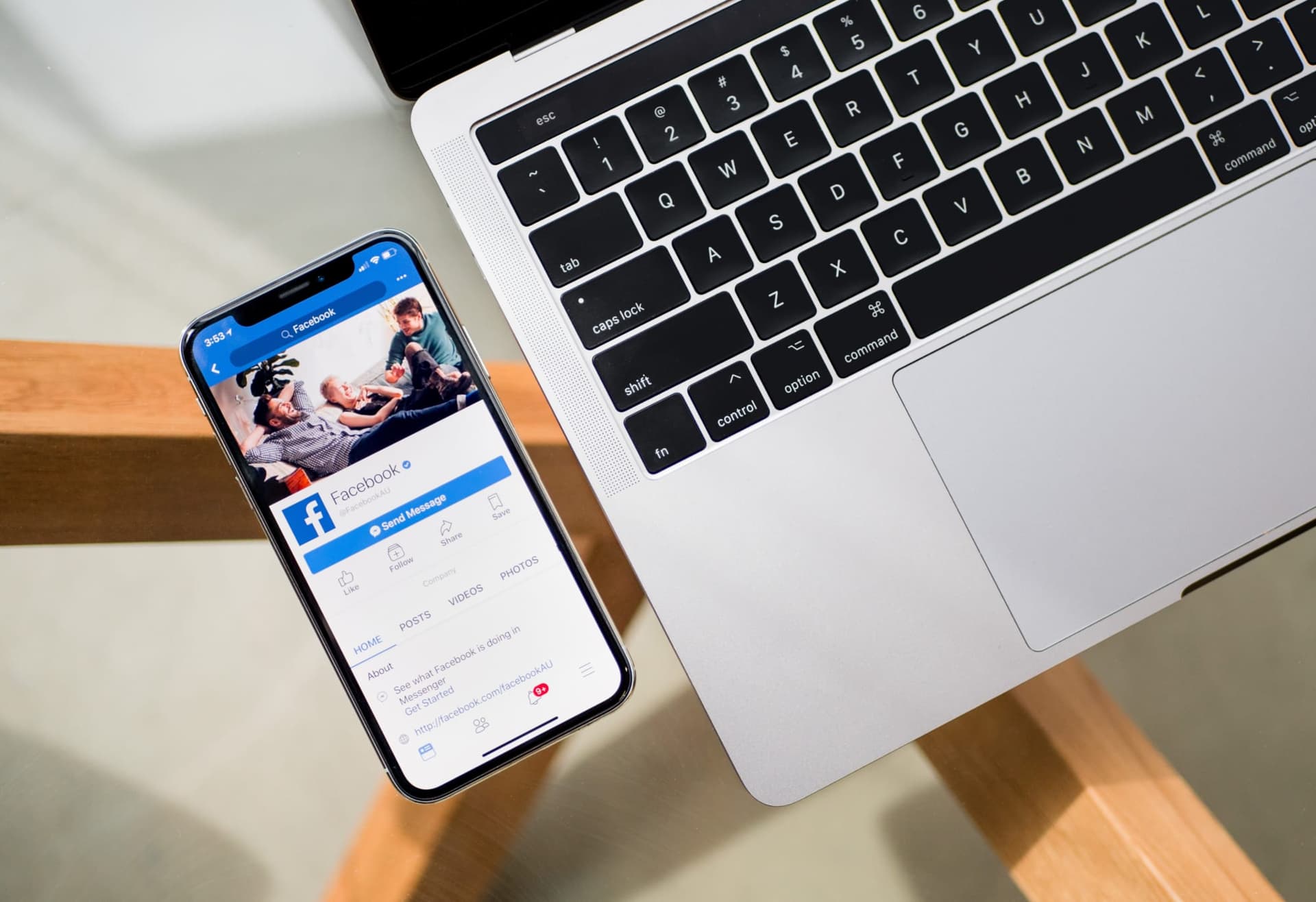Social media sites like Facebook and Twitter offer a unique opportunity to get close to people who are hundreds of miles away. You can share anything with anyone at any time.
You can share.
Does this mean that you should share?
I’ve come up against this question many times, hovering over the Send button on a status update or considering what’s okay to share and what’s too private (or uninteresting). Where should the line be drawn? Should there even be a line?
I’m happy to offer some of my thoughts and ideas below, and I’d love to hear from you, too. How much of yourself do you share on social media? And do you feel it’s enough? Let’s discuss together.
Authenticity vs. Transparency vs. Vulnerability
When I try to wrap my head around the notion of how much of myself to share on social media, I often end up with a jumble of words and ideas. It helps to line them out and consider each carefully.
Let’s start with the two big ones: authenticity and transparency. These two often become interchangeable to me when they really shouldn’t. They’re two separate ideas.
Authenticity = Sharing genuinely = The way you share
Transparency = Sharing deeply = The things you share
One of my go-to explanations for the difference here is this simple explanation from Pam Moore:
Transparency is how much you share and authenticity is the truth of your words and actions.
Now we’re getting somewhere. With these definitions in tow, we can start to draw some conclusions.
- Authenticity stands apart, regardless of how much you share.
- You can be authentic without sharing everything.
- You can choose your level of transparency and remain authentic throughout.
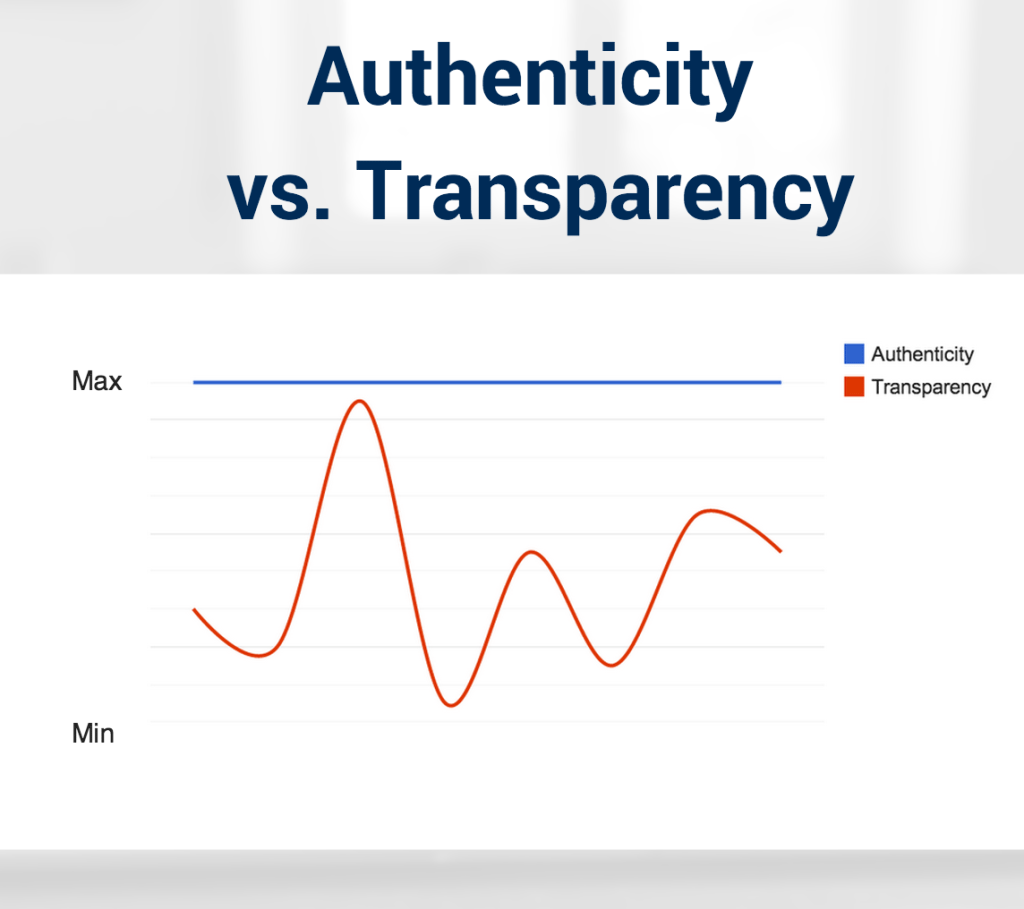
In this sense, one might conclude that you never need to be anything other than 100 percent authentic with the updates that you post to social media.
Always be authentic.
Be varying degrees of transparent.
At Buffer, we’ve taken transparency to heart—and to the extreme. We share our salaries with everyone. We blog about our specific strategies for growth. We publish our personal improvements live on the Internet for all to see every single week. Transparency holds a special place in our company culture, and it has been a hallmark of the way we’ve gone about our business.
Most other companies fall a little closer to the median on the spectrum of transparency, and this is fine—provided authenticity on social media remains a priority. You can share little bits and pieces, so long as they’re genuine bits.
Now that we’ve discussed authenticity and transparency, let’s throw one more factor into the mix: vulnerability. Research professor Brené Brown is one of the leading voices on the topic of vulnerability, having studied it in great detail and having written about it in her book Daring Greatly. Here’s her definition of vulnerability:
Vulnerability sounds like truth and feels like courage. Truth and courage aren’t always comfortable, but they’re never weakness.
To carry this definition over to social media, you might say:
Vulnerability = Sharing courageously about good and bad
So let’s reexamine our three factors now.
- You should be authentic 100% of the time.
- You should be transparent with whatever you choose.
- Your comfort level with vulnerability will help determine your level of transparency.
How do those definitions feel to you?
I’ve grabbed a couple examples of how this plays out in the real world of social media so you can see what these factors look like in practice. The first story makes quite the case for authenticity.
4x more followers simply by being authentic
Brian Fanzo of Broadsuite delivered a really neat story and comment on
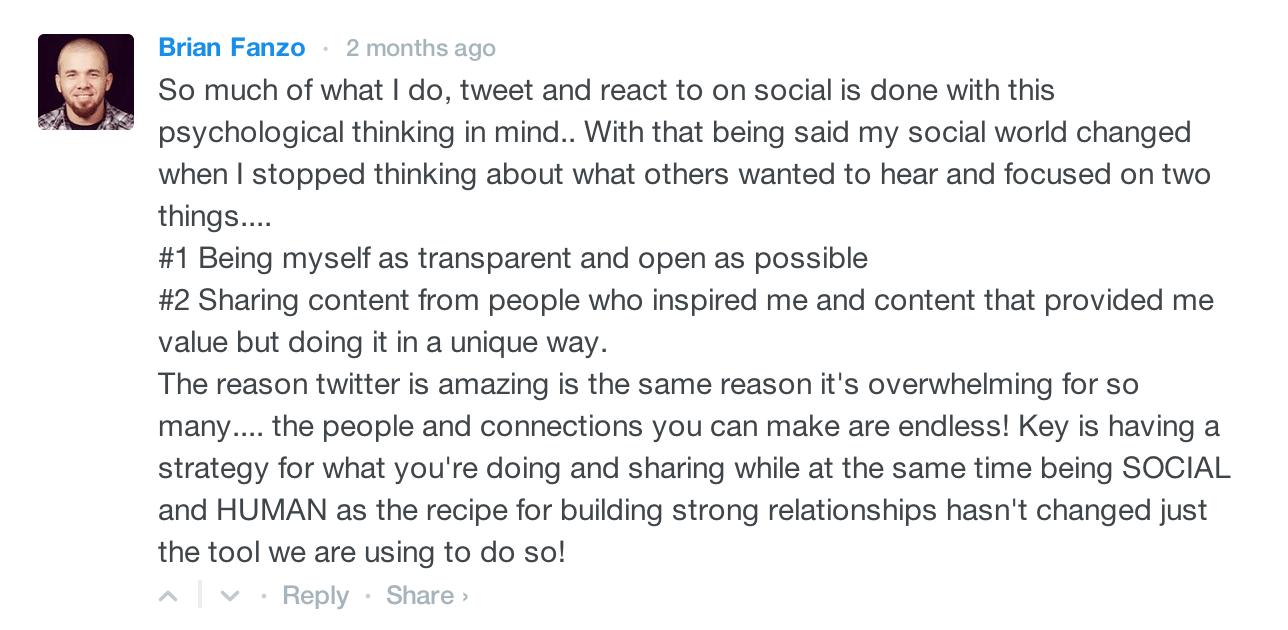
My social world changed when I stopped thinking about what others wanted to hear and focused on two things….
The reason Twitter is amazing is the same reason it’s overwhelming for so many…. the people and connections you can make are endless! Key is having a strategy for what you’re doing and sharing while at the same time being SOCIAL and HUMAN as the recipe for building strong relationships hasn’t changed just the tool we are using to do so!
Doing this drastically changed my engagement, shares, and overall social relationships. By sharing and helping and joining Twitter chats it opened up the communities that I was able to reach. I went from 3,000 followers at the start of 2014 to 14,000 today—Without ever focusing on gaining followers, rather sharing great content and being myself.
Much of the advice I’ve shared about follower growth in past posts on the Buffer blog relies on scientific research and best practices, advice like “use positivity in your updates” and “post more than you’re posting now.”
This advice is all well and good. Brian’s story shows there might be other, simpler alternatives, too.
Share what you’re comfortable with
Author, blogger, and web designer Paul Jarvis held a live Q&A session via Google Hangout this summer, letting fans and followers ask him any question they wanted (a great example of vulnerability in practice).
Here is one of the questions that came in. Sound familiar?
Are you naturally comfortable sharing your personality online? If not, how do you develop that ability? I feel that I have an awkwardness barrier even after working at this for years.
Paul’s answer:
The biggest thing is that I don’t really share all of myself or my personality online. I share what I’m comfortable with.
(The specific question comes at the 3:00 mark.)
We know many specific things about Paul from what he’s shared online—e.g., he is vegan, he owns pet rats. Yet these are only a few isolated parts of his day-to-day life that he’s offered to share.
What do you know about me from social media? I’ve taken the same approach as Paul, sharing what I’m comfortable with and doing so specifically. From following me online, you may know that I like football, I like cheesy jokes, and I take a lot of pictures of my keyboard.
My new writing partner. Great work ethic. Misspells “the” when in a hurry. pic.twitter.com/QcsuscrRZ4
— Kevan Lee (@kevanlee) March 3, 2014There’s a lot more to me than these three parts, of course. For instance,
I am super madly deeply in love with my wife and son, yet I’ve chosen to keep them off the grid. Maybe some day my transparency will change. For now, I’ve found a comfort zone with sharing just enough and sharing it with authenticity.The takeaway: Choose what you’re comfortable with sharing. Share specifics. Share authentically.
How authenticity fits with voice and tone
We’ve talked before about the importance of voice and tone for your marketing and branding. Voice is like a mission statement for the way you post on social media, and tone is the application of that mission.
MailChimp has a great example of how this voice and tone plays out in a variety of ways.
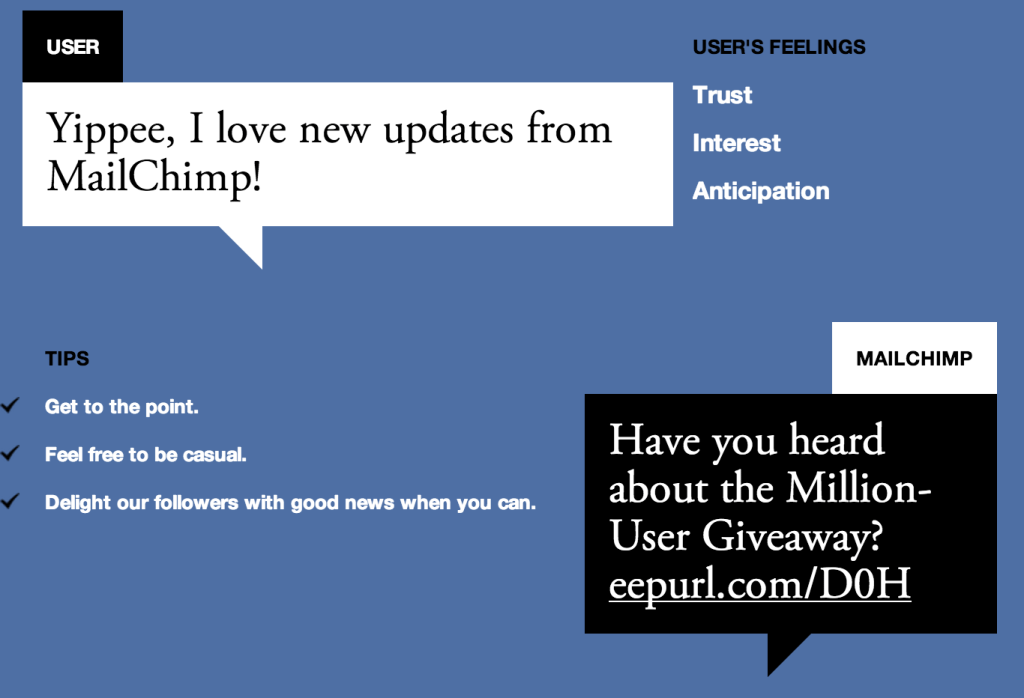
It’s best to have a consistent voice and tone. For example, if your voice is one of positivity, there’s no room for negativity.
So what if something negative happens?
- You could spin it to find the silver lining.
- You could stash it away and never post it.
To keep with voice and tone, you’re often presented with these two choices: shaping the experience to fit your style or avoiding the experience altogether. What you decide to do will largely depend on the level of transparency and vulnerability you’ve chosen.
In either case, you can always view the matter of voice and tone as an extension of authenticity. There’s an element of reliability with authenticity. Authentic people are dependable in the way they post. Voice and tone—even in tough situations—can help support this feeling of authenticity.
The 3 questions I ask myself when deciding what to share
One of the neatest stats that I’ve read lately about social media came from a post Courtney shared about psychological studies. Facebook tracked 3.9 million users over a 17-day period and found that 71 percent of users typed out at least one status or comment and then decided not to submit it. On average, these folks changed their mind on 4.52 statuses and 3.2 comments.
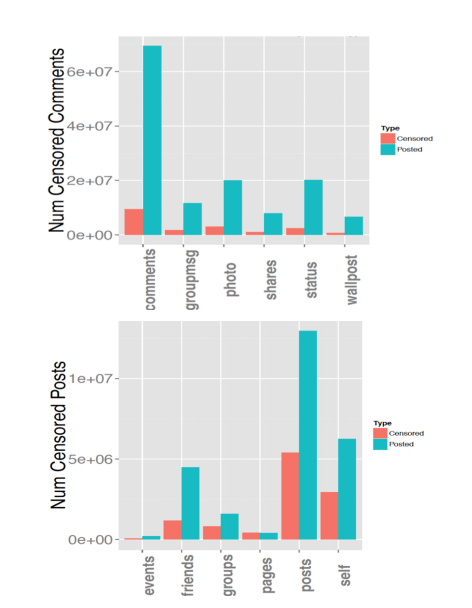
Would you fall into one of those categories?
Just the other day, I was tempted to post what I thought was a funny observation about my experience at a website. Thankfully, I let the update sit in my Buffer queue over night, and I thought better of it the next day.
How do we end up deciding what gets posted and what gets shelved? I’d expect you have a few questions you might ask yourself when determining if a piece of content is post-worthy or not. Here are the questions I’ve found most helpful.
- Would others find it interesting?
- Is it revealing a part of me that I’m comfortable with sharing?
- Does it fit with the message I want to express on social media?
Over time, I’ve found that the first two questions get easier to answer as I get better at recognizing what’s interesting and shareable. The third question—“is it on-message”—takes a bit more contemplation. I’ve left off plenty of updates that didn’t seem to be a perfect fit with the values I want to express in my social sharing (positivity, helpfulness, simplicity).
Is the extra time it takes to vet these updates worth it? I’ve found that it absolutely is.
Recap
Share with authenticity on social media, all the time.
Share transparently, as much as you’re comfortable.
Be vulnerable if you choose.
The first element is required for social media—most folks can sniff an inauthentic account from a mile away. The second, transparency, is required to varying degrees. You choose the level you want to expose. And if you’re comfortable with a degree of vulnerability on social media, all the better.
How do you decide how much of yourself to share on social media? What has the experience been like for you?
I’d love to hear your thoughts in the comments.
Image credits: Death to the Stock Photo, Sauvik
Try Buffer for free
190,000+ creators, small businesses, and marketers use Buffer to grow their audiences every month.



